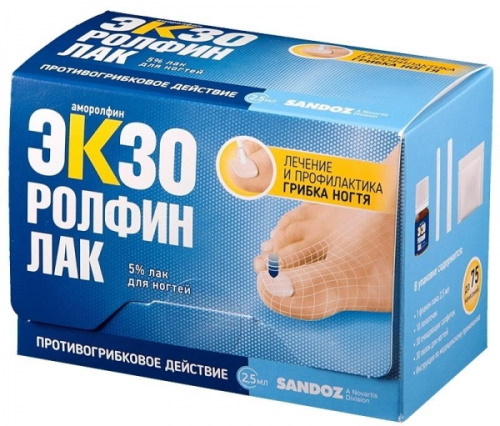Content
- Stages and degrees
- Symptoms and Signs
- Causes
- Diagnostics
- Treatment methods
- Drug-free treatment
- Drinking liquids
- Body position
- Wearing compression stockings or a bandage
- Increased sodium intake
- Food
- Exercises
- Pharmacotherapy
- Midodrin
- Dihydroergotamine, an ergot alkaloid
- Clonidine
- Fludrocortisone
- Erythropoietin
- Octreotide
- Indomethacin
- Yohimbine
- Possible consequences and complications
- Orthostatic Hypotension Videos
Orthostatic or postural hypotension - this is the gravitational redistribution of blood at the time of a sharp change in a person's position from horizontal to vertical. In this case, the force of gravity acts on the vascular system, reducing the volume of blood returning to the heart.
Inferior venous return decreases the volume of blood available for pumping from the heart, causing a short-term drop in blood pressure. The disorder occurs due to improper regulation of blood pressure due to various disorders. OH is not an independent disease, but more and more evidence suggests that impaired a hemodynamic response to simple movements increases the risk of developing cardiovascular disease and mortality.
Stages and degrees
Medical sources describe 3 degrees of OG:
- Hypotension itself. It is determined by a steady decrease in pressure by 20 mm Hg. Art. systolic blood pressure, and 10 mm Hg. Art. diastolic blood pressure within 3 minutes after rising from a supine position.
-
Delayed stage of orthostatic hypotension. Determined by a steady decrease in blood pressure after 3 minutes of standing. Patients with delayed OH stage tend to have fewer adrenergic (weakness, palpitations, tremors) symptoms with hypotension, indicating a milder form of the disease.

- Initial stage. This is a temporary decrease in blood pressure (systolic blood pressure ≥ 40 mm Hg. Art., diastolic blood pressure ≥ 20 mm Hg. Art.) for 15 seconds. after lifting from a supine position. It is more common in young people, is not associated with significant morbidity and mortality, but the pathophysiology of the disorder is not fully understood.
Symptoms and Signs
Orthostatic hypotension occurs when blood pressure drops sharply when too little blood is supplied to the brain. Insufficient cerebral blood flow manifests itself in various symptoms. Some people suffer from dizziness every time they get up, other times, symptoms only occur with physical stress, such as dehydration or illness. Blood pressure can drop sharply even after a heavy meal.
However, some people may have no symptoms despite a sharp decrease. To check for orthostatic hypotension, the doctor should check the blood pressure when standing up. A decrease in the systolic parameter by more than 20-30 mm Hg is typical. Art. or when the diastolic value falls by 10 mm Hg. Art. standing for 3 minutes.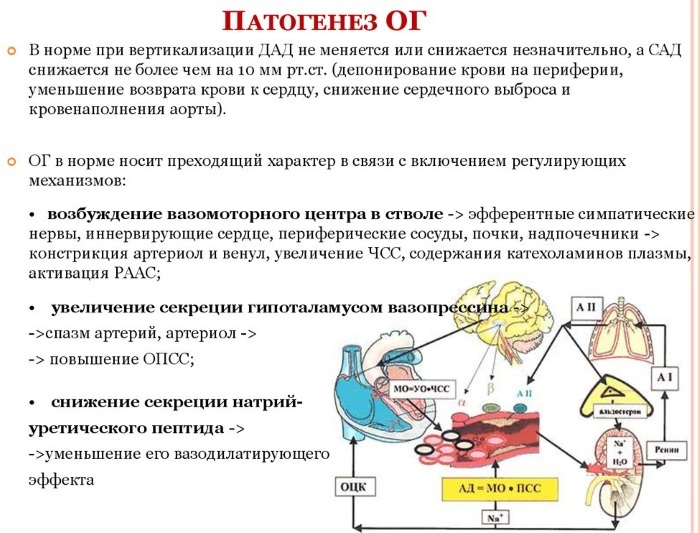
Signs of orthostatic dysregulation:
- drowsiness;
- dizziness;
- blurred vision;
- fainting;
- confusion of consciousness (rare);
- breathing disorder;
- nausea;
- headache;
- pain in the neck and chest when standing.
Symptoms may worsen in the morning, in an excessively hot environment, with prolonged standing, and with getting up after a period of prolonged sitting, after eating, or after taking a bath. Some patients do not show all symptoms despite low BP values. In these cases, autoregulation (a defense mechanism) is thought to keep the blood supply to the brain.
Causes
Loss of fluid in the blood vessels is the most common cause of symptoms associated with orthostatic hypotension.
When a person rises from a prone position, gravity forces the blood to move towards the legs. At the same time, the pressure drops slightly due to the fact that at that moment less blood returns to the heart. The body immediately compensates for this fluctuation by constricting the blood vessels in the legs and causing the heart to beat faster. The autonomic nervous system is responsible for these circulatory reflexes.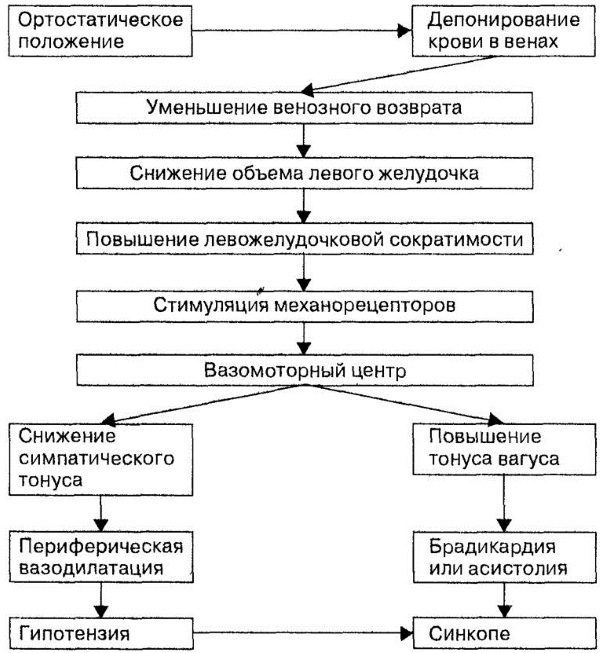
It is the part of the nervous system that unconsciously controls body functions such as heart rate, body temperature, blood pressure, and digestion.
Possible reasons for the violation of orthostatic regulation:
- Hormonal changes (insufficient activity of the thyroid gland, adrenal cortex or anterior pituitary gland).
- Diseases of the heart and blood vessels (narrowing of the aorta, heart failure, abnormal heart rate, pericarditis).
- Prolonged bed rest.
- Constant lack of exercise.
- Lack of fluid in the body (especially in older people who reduce their water intake).
- Side effects of medications.
Orthostatic hypotension occurs with the use of certain drugs. This happens as a side effect, for example, when taking medications for high blood pressure (hypertension), an enlarged prostate, or depression.
Sometimes the cause is diseases in which the cells of the autonomic nervous system or the chemical balance of the body are disturbed.
The reasons influencing the development of the syndrome:
| Neurological | |
| CNS | Multisystem atrophy |
| Parkinson's disease | |
| Multiple stroke | |
| Spinal cord | Transverse myelitis |
| Tumors | |
| Peripheral | Amyloidosis |
| Diabetic, alcoholic neuropathy. Guillain-Barré Syndrome Vegetative failure Paraneoplastic syndromes | |
| Cardiovascular | |
| Hypovolemia | Adrenal insufficiency |
| Dehydration | |
| Hemorrhage | |
| Compromise of vasomotor tone | Aortic stenosis |
| Heart failure | |
| Myocardial infarction | |
| Tachycardia or bradycardia | |
| Miscellaneous | Peripheral venous insufficiency |
| Pheochromocytoma | |
| Medication | |
| Vasodilators | Calcium channel blockers |
| Nitrates | |
| Active autonomic nervous system | Alpha blockers |
| Antipsychotics. | |
| Tetracyclic antidepressants | |
| Miscellaneous | Alcohol |
| Barbiturates | |
| Loop diuretics | |
| Levodopa drug |
With age, the autonomic nervous system gradually loses its ability to optimally compensate for fluctuations in blood pressure caused by gravity.
Diagnostics
The cardiologist and therapist jointly diagnose and prescribe treatment for orthostatic hypotension and collapse. Functional diagnostic tests are performed initially. On their basis, the dynamics of various parameters of blood circulation is determined when the position of the body changes.
The tests are carried out with active and passive orthostatic loading:
- In the first case, a weakened participation of skeletal muscles in the process of orthostatic adaptation is assumed. This is achieved by passively transferring the subject's body from a horizontal position to a semi-vertical or vertical position on a special rotating table. The patient lies on a flat table that tilts to raise the upper body, simulating a motion from lying to standing up. Blood pressure is measured frequently, with each table rotation.
- In the second case, the patient independently moves from a lying position to a standing position. This load case is used in Martine's test. The compression cuff, which is not removed until the end of the study, measures the pressure after each of the 20 squats.
- Orthostatic tests using pharmacological agents are carried out in order to study the function of the cardiovascular system. OP to control drug treatment is most often used in patients with arterial hypertension in the first days after prescribing drugs.
Clino-orthostatic tests can be done in a network of different clinics. Cost from 2 thousand. rub. Underlying medical conditions, such as anemia or lack of fluid, can be diagnosed with blood and urine tests.
If the cause is not obvious, additional tests are done:
- ECG;
- measurement of serum electrolytes (280-300 rubles);
- taking blood for creatinine (200-300 rubles),
- thyroid-stimulating hormone analysis (400 rubles)
- determination of glucose in the blood (280 rubles).
However, these and other tests often provide little information beyond the presence of specific symptoms. Other tests are done depending on the results of the scan, especially if symptoms indicate a heart or nervous system problem.
If the drug is suspected of causing dizziness, the patient may be asked to stop taking the drug and see if the dizziness subsides, which confirms the cause.
Treatment methods
Orthostatic hypotension requires treatment, which depends on the severity of the disease. The disorder often occurs suddenly, as occurs with myocardial infarction, arrhythmias, cardiomyopathy, and aortic stenosis.
If possible, the cause is eliminated, including replacement or discontinuation of any medication. However, many causes cannot be cured, and affected people must take steps to reduce their symptoms. These include lifestyle changes.
Drug-free treatment
Once a diagnosis is made, the goal is to relieve symptoms. In the case of mild exhaust gases, physical measures are sufficient.
Drinking liquids
With your doctor's approval, you should consume more liquid, salt, or adjust your medication dosage to reduce side effects. Fluid intake should be increased to 3 li per day and salt intake to 1200 mg / day.
Body position
During a night's sleep, the upper body should be raised 12 °, preferably 45 ° from the horizontal. This leads to a decrease in sodium excretion at night and urine volume. After waking up in the morning, you should straighten slowly and gradually.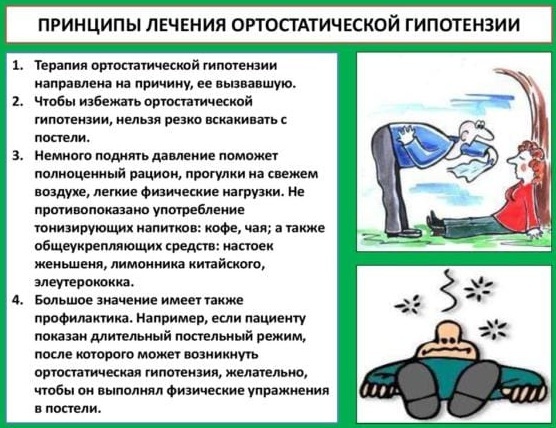
In patients with isolated autonomic insufficiency, an increase in the maximum standing time from 3 to 10 minutes significantly improves their mobility. With a sharp drop in blood pressure, you can cross your legs while standing and squeeze your hips together. Alternatively, you can put one foot on a step or chair and bend over, but only enough to feel safe. Exercises like these activate the muscles and stimulate blood flow from the legs to the heart.
Wearing compression stockings or a bandage
Wearing compression stockings or a compression abdominal bandage stabilizes blood circulation and prevents blood from stagnating in the legs. To achieve maximum effect, tights should be worn in the morning while lying down, before the first rise.
Increased sodium intake
Increasing sodium and water intake can increase intravascular volume and reduce symptoms. For patients without heart failure or high blood pressure, sodium can be increased to 6-10 grams per day by consuming abundant salt or prescribing sodium chloride tablets.
This measure is associated with a high risk of heart failure, especially in the elderly and in patients with impaired myocardial function. The development of edema in the contracting areas of the body without heart failure is not a contraindication for the continuation of this therapy.
Food
Deterioration of exhaust gas during the first 30 minutes after eating is due to insufficient increase in cardiac output, secretion norepinephrine and vascular resistance as a countermeasure to the vasodilating effects of intestinal and pancreatic peptides. Since the carbohydrate content is responsible for the drop in blood pressure, the daily amount of carbohydrate intake should be divided into several small portions throughout the day.
The possibilities of physiotherapy are used in practice only in part due to illness or negative motivation of the person. In many cases, this means that additional pharmacological therapy is needed.
Exercises
Orthostatic hypotension occurs with a sharp rise, especially in patients who are on prolonged bed rest. They should try to spend some time sitting every day, if possible, go in for sports.
Regular, moderate-intensity exercise will increase vascular tone and reduce blood congestion in the venous system. Elderly people should avoid prolonged standing. Raising the head of the bed at bedtime can relieve symptoms by stimulating sodium retention and reducing nighttime urine output.
Pharmacotherapy
If the measures described above are not enough, then the doctor prescribes drug treatment. The course of therapy, first of all, must be carefully monitored. Initial hypersensitivity to many drugs is possible, and a combination of physical and drug measures to increase intravascular volume can lead to fluid overload, edema and cardiac problems.
Midodrin
Midodrine relieves symptoms, constricts blood vessels and raises blood pressure. The drug should not be used with high blood pressure, untreated glaucoma, during pregnancy, severe overactive thyroid gland, other severe diseases of the heart and blood vessels, disorders urination.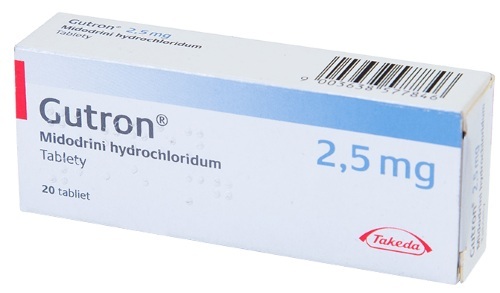
Side effects include frequent urination, piloerection, increased blood pressure in lying down, less often a feeling of coldness in the arms and legs, anxiety, palpitations and cardiac arrhythmia. The medicine is recommended to be taken 4-5 hours before bedtime.
Dihydroergotamine, an ergot alkaloid
Side effects include anxiety, nausea, headache, less often angina pectoris, and peripheral circulation disorders.
Clonidine
Clonidine also constricts blood vessels and raises blood pressure. Dry mouth, confusion and high pressure crises are to be expected as side effects.
Fludrocortisone
Even low doses cause sodium retention in the body and the excretion of large amounts of potassium. This leads to an increase in blood pressure. Side effects: hypokalemia, metabolic alkalosis, edema (accumulation of water in the legs), increased blood pressure.
Erythropoietin
Erythropoietin, a hormone that stimulates the production of red blood cells, can be used if anemia is the cause. Not all doctors recommend this drug for this indication as it causes headaches, seizures, edema, and high blood pressure.
Octreotide
The drug will be beneficial if symptoms occur only after eating. The medicine is administered by injection. The most common side effects are nausea and abdominal cramps.
The use of indomethacin (25–50 mg) is often limited by gastrointestinal side effects. Treatment with indomethacin is especially beneficial for patients who for other reasons require a non-steroidal anti-inflammatory drug.
Yohimbine
Yohimbine (2.5–5 mg) is also commonly used for treatment. Lowering blood pressure at night increases the risk of falling while standing up.
Possible consequences and complications
Orthostatic hypotension occurs when blood pressure drops sharply and can lead to serious complications. Falling due to fainting is a common complication in people with OH, leading to injury and hospitalization. Orthostatic hypotension as a side effect of antipsychotic, antidepressant drugs, diuretics, antihypertensive drugs, is becoming more common and contributes to falls and fractures, especially in the elderly of people.
According to various studies, orthostatic hypotension is associated with a significant increase in the risk of death from coronary heart disease, heart failure, and stroke.
Scientists have found that orthostatic hypotension may be associated with an increased risk of developing dementia in the long term, such as Alzheimer's, by 15%. The most obvious explanation for these findings is that frequent transient cerebral hypoperfusion during orthostatic hypotension can lead to brain damage.

Due to insufficient blood supply to the heart muscle, low blood pressure can sometimes cause chest pain or shortness of breath (angina).
Orthostatic hypotension differs from normal hypotension in that blood pressure decreases only with a sharp rise from a sitting or lying position, after which, in most cases, the condition quickly returns to normal. With normal hypotension, low blood pressure is observed almost constantly, regardless of body position.
Exhaust gas duration for more than a few minutes after waking up can be a sign of a serious illness, so people with this problem should see a general practitioner or cardiologist. Only the identification of the causes of the occurrence of exhaust gases and their elimination can lead to a complete recovery.
Orthostatic Hypotension Videos
Malysheva about orthostatic hypotension:

